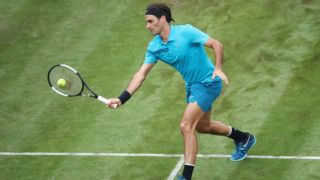|
Now that another clay-court season dominated by Rafael Nadal is over and it's safe for Roger Federer to go outside again, the all-time Grand Slam singles champ is fired up for the grass-court season. "I'm super happy to be back on tour," Federer said in his on-court interview following his 2018 grass-court debut Wednesday in Stuttgart, where he logged a crisp, three-set win over Mischa Zverev. "It's been a great start. It feels good to win again." The Wimbledon champion left the tour 81 days earlier with back-to-back losses stuck in his craw -- the first to Juan Martin del Potro in the Indian Wells final, then a Miami Open first-match disaster against 21-year-old Thanasi Kokkinakis. The losses blunted another gravity-defying liftoff this season by Federer (the 2017 champ at both Indian Wells and Miami), who started the year with a 17-match win streak, including an Australian Open final. A mere March glitch or something larger? Federer took his sweet old time answering the question, putting his feet up for the entire clay-court season while Nadal & Co. knocked themselves out grunting, sliding and vamos-ing their way through red dirt wars. They played some sets that lasted longer than Federer's 92-minute win over Zverev -- and that was a match that went the distance. That's the nature of grass-court tennis; it's more shouting match than clay-court conversation, with the points flying by in a blur of serves, volleys and passing shots. Finally taking the advice Pete Sampras and others offered him over a decade ago, Federer has become in recent years a slashing, dashing, attacking grass-courter. Federer's evolution has paid such great dividends that he's been able to remain a Euroclay refusenik and still retain his No. 2 ranking, just a few unforced errors off Nadal's pace, despite those March failures. And now comes his happiest season. "On grass, my expectations are high," Federer told reporters early this week. But Stuttgart is also one of the very few places where his hopes have been stymied. He's never won the title, while he's toted off the trophy just down the autobahn in Halle a Nadal-esque nine times. Federer was knocked out in the third round in 2016 by rising Dominic Thiem. Then last year, Federer, 35 at the time, actually lost to an older guy, 39-year-old Tommy Haas. This could be a bellwether tournament for Federer at a time when the game may be shifting under the players' feet once again. For about the last decade, defense, and particularly the ability to transition from defense to offense, was the ruling skill. It lifted Novak Djokovic and Andy Murray into full membership in the Big Four. Now, thanks partly to Federer's success, more players seem focused on pre-emptive ball-striking and offense. Zverev is an example, but so what? He's ranked No. 54 and hasn't ever won a title. Well, his brother Alexander trends that way, too. And at 21 and already the owner of three Masters titles and a No. 3 ranking, Alexander looks a lot like the future of the ATP.  Federer may meet any of two proponents of the "think offense" movement if he hopes to lock down the Stuttgart trophy. A quarterfinal win by Federer on Friday could pit him against No. 4 seed Nick Kyrgios, with No. 7 seed Milos Raonic penciled in as a potential finalist. A matchup against the latter would be a reprise of the 2016 Wimbledon semifinal won by Raonic. Things haven't gone so well for the lanky 6-foot-5 Canadian since then. Laid low by a series of injuries, he's breathing through his nose right on the .500 waterline at 56-28 since that landmark conquest of Federer. Raonic has played just two finals, both in minor ATP 250 events, winning neither. His ranking has dipped from No. 3 to as low as No. 38, but he appears to be healthy again at just the right time for his whopper of a serve to do utmost damage. Kyrgios has woven himself a similar plot. The latest is a sore elbow that kept him off red clay for most of the spring. But when he's healthy, there isn't a more dangerous example of a player who can slash as well as crash, mixing rocket serves with swerving slices and flat forehands. There are always power players around, but a lot of them -- including del Potro, Kevin Anderson, John Isner, Lucas Pouille (while a Frenchman raised on clay, he clocked the second-fastest serve at Roland Garros this year), even Thiem -- seem to be doing especially well lately. Maybe the trick to beating Federer's jazzy offense isn't great defense but superior offense and firepower, as del Potro and Kokkinakis demonstrated. Kokkinakis was just a qualifier. But he has an outsized game and massive serve. He put a lot of pressure on Federer throughout their three-set clash in Miami. When it was over, Federer said, "Wrong decision-making by me, good decision-making by him. It's disappointing." Federer is generally famous for his wise decision-making, but the court is one place where it's possible to pressure him into making a poor choice or even an error. He has his work cut out.
|
